Random viewing, short takes
Once again I’m way behind in commenting on what I’ve been watching; so once again, here are some quick thoughts on a miscellaneous selection of recently viewed disks.
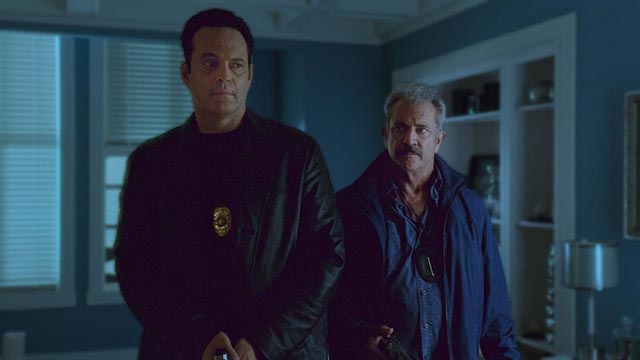
in S. Craig Zahler’s Dragged Across Concrete (2018)
Dragged Across Concrete (S. Craig Zahler, 2018)
I haven’t seen the first two features by S. Craig Zahler, but I picked up his most recent movie on a whim when its odd title caught my eye. Dragged Across Concrete (2018) is a crime movie about a pair of cops suspended because they were recorded being rough with a suspect during an arrest. The older cop, Brett Ridgeman (Mel Gibson), is nearing retirement, exhausted and bitter – his teenage daughter is regularly harassed in the street on her way home from school, his wife is crippled by painful MS, and he has no money. So he goes to a shady character he once helped (the inimitable Udo Kier) and asks for the name of someone he can safely knock over for some quick cash.
Ridgeman persuades his younger partner, Anthony Lurasetti (Vince Vaughn), to join him on the deal and they stake out the perp’s place, waiting for an opportunity to move in and take what they think will be money from a drug deal. But the guy isn’t dealing drugs. He’s planning a bank robbery with a couple of extremely violent men – we see them randomly killing people during a string of petty crimes. The two cops follow the gang on the day, realize what’s going on, but don’t step in to interfere – resulting in multiple deaths in the bank. Implicated by their inaction, they follow the gang out of town to a remote location where they become involved in a violent showdown over the stolen gold. It doesn’t end well.
While the narrative is not particularly original, Zahler’s style makes it fresh. The pace is leisurely (it runs two-and-a-half hours), giving the characters plenty of time to breathe. He lingers on conversations, not in Tarantino’s clever, show-offy way, but rather as real people might talk, edging around subjects, testing each other, trying to figure out complex issues without necessarily addressing them head-on. This all works because the cast is excellent – Thomas Kretschmann is the guy in charge of the robbery, Tory Kittles and Michael Jai White are a pair of smalltimers who sign on as drivers without realizing just how vicious the guys they’re working for really are, and Gibson and Vaughn are convincing as long-time partners who are uneasy with the choices they find themselves making – and because the movie is so well shot by Benji Bakshi and edited by Greg D’Auria. (VVS Films Blu-ray, with a number of making-of featurettes)
*

All the Devil’s Men (Matthew Hope, 2018)
At the same time, I picked up a movie called All the Devil’s Men (2018) largely out of curiosity because it stars Mel Gibson’s son Milo in his first leading role. It’s a dour, rather sluggish thriller, coincidentally also the third feature of its writer-director, Matthew Hope. It’s the story of Collins (Gibson), a weary CIA assassin (are there any other kind?), who is tasked by his handler Leigh (Sylvia Hoeks) with taking down McKnight (Elliot Cowan), a renegade arms dealer looking to sell a small nuclear bomb to jihadis. Leigh has personal reasons for wanting the dealer dead (he killed her father), and Collins has personal reasons for being reluctant to get involved – one of the bad guy’s henchmen is Deighton (Jospeh Millson), a former comrade whose life Collins saved in Afghanistan.
The plotting is convoluted, loaded with deception and betrayals – eventually Leigh even sells Collins out to Deighton in her obsession with seeing McKnight dead. The narrative is kind of stale, and Gibson the Younger has very little screen presence, but one thing to like is Hope’s use of unfamiliar, run-down locations in and around London. One thing not to like is how quickly he disposes of the best actor in his cast: William Fichtner. (Bare-bones M.O. Pictures Blu-ray)
*
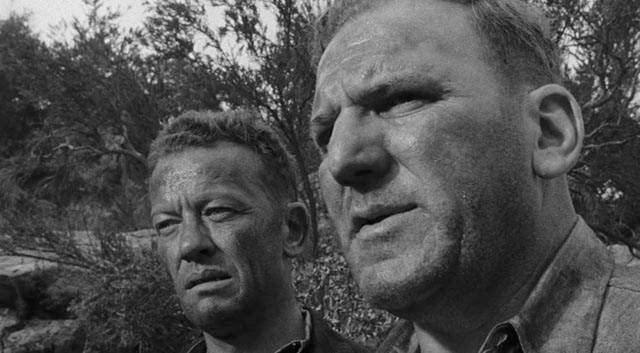
Crashout (Lewis R. Foster, 1955)
I really enjoyed Lewis R. Foster’s Crashout, a B thriller from another cinematic age. No big themes here, but plenty of duplicity and betrayal in the story of a group of cons who break out of prison together and try to make it across country to retrieve some loot buried by their leader, Duff (William Bendix). Packed with a cast of great character actors – Arthur Kennedy, Luther Adler, William Talman, Gene Evans, Marshall Thompson, Percy Helton – this is a taut, spare movie without a wasted moment, co-written by director Foster and producer Hal E. Chester. The central conflict is between the vicious Duff and the decent but nonetheless guilty Quinn (Kennedy), who tagged along on the escape without being invited.
As the gang make their way to snowy mountains where the loot is hidden, they threaten, abuse and kill anyone who gets in their way, their numbers dwindling as they too get themselves killed in various encounters, until it’s just Duff and Quinn on a freezing mountainside. This is the kind of simple, efficient filmmaking which has largely gone out of style as spectacle has become the dominant mode in commercial movie-making. (Bare-bones Olive Films Blu-ray)
*
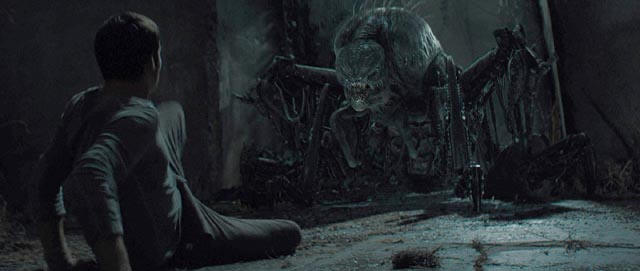
Maze Runner Trilogy (Wes Ball, 2014-18)
Spectacle is definitely what you get in Wes Ball’s Maze Runner Trilogy, adapted from a series of young adult novels by James Dashner. Like so many young adult fantasies, it takes place in a dystopian future where kids are victimized by the oppressive forces which run the world. Here, in the wake of a global catastrophe which has wiped out a lot of the world’s population, infecting most of the rest with a zombie virus, we meet a group of kids exiled for unknown reasons to the Glade, a fertile clearing in the middle of the Maze. The Maze itself is vast, with high stone walls which every night shift and realign into different configurations. Runners are those who spend their days inside the Maze, mapping the changes (there are eight different configurations) and avoiding the Grievers, giant bio-mechanical bugs which sting with syringes loaded with the zombie virus.
The kids haven’t found a way out of the Maze, but they have established a kind of equilibrium, building a community, growing crops. All this is disrupted with the arrival of a new exile, Thomas (Dylan O’Brien), who refuses to accept the status quo. His attitude rubs some of the kids the wrong way – justifiably, it seems, when his actions disrupt the equilibrium, leading to a swarming attack on the community by the Grievers. But Thomas eventually manages to lead a group out of the Maze, discovering a lab complex where scientists have been doing experiments on survivors of the catastrophe under the direction of the cold-blooded Ava Paige (Patricia Clarkson). It turns out the kids in the Glade (and, we later learn, in other Glades elsewhere) are naturally immune to the plague and the scientists are using them to find a cure.
Having escaped the Maze at the end of the first movie, the series becomes a more familiar zombie apocalypse narrative, with the kids fighting against the corporation which has been using them, joining a resistance army, and eventually taking the fight back to the bad guys. But to the films’ credit, the bad guys are treated with some nuance so the story does explore the moral costs of the characters’ decisions and the price of survival.
Ball directs it all with energy and a degree of style, keeping the story moving and maintaining viewer interest. Not only is the trilogy better made and more watchable than the tedious Hunger Games series, it’s also a better zombie apocalypse epic than World War Z. Though after it’s over you’re left wondering what the hell was up with the Maze? How trapping the kids inside has any utility in the search for a cure is never really explained, and why the corporation should have built/bred the Grievers is also unclear – that’s an awful lot of money and effort in a world with apparently few remaining resources. The Maze and its menaces make for impressive visuals and some high-concept action, but they’re completely forgotten once the kids escape. (Six-disk dual-format set from 20th Century Fox packed, as they say, with hours of special features: deleted scenes, production featurettes, commentaries)
*
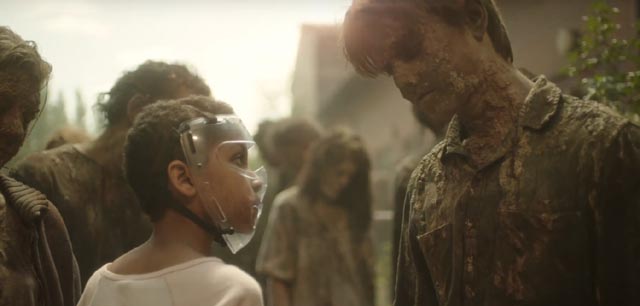
The Girl with All the Gifts (Colm McCarthy, 2016)
Speaking of zombie apocalypses, a couple of weeks back I came across a discount Blu-ray of a movie I’d never heard of in a local store – Colm McCarthy’s The Girl with All the Gifts (2016). A couple of things caught my attention when I looked at the cover: it’s English, and I’ve been partial to English disaster stories since childhood exposure to the novels of John Wyndham and John Christopher; and the cast was intriguing – Paddy Considine, Gemma Arterton and Glenn Close. It turned out to be well worth the six bucks I paid for it. Once again, it’s not originality that matters, but rather the way the familiar elements are handled – and enhanced by a few less familiar touches.
In a bunker run by scientists and the military, a group of children are being run through experiments. These kids are infected with a zombie fungus, but rather than succumbing, they seem to have a symbiotic relationship with it. They appear quite human, as smart and articulate as kids can be, yet they crave human flesh and will tear the surviving adults apart if given the opportunity. Teacher Helen Justineau (Arterton) has formed a bond with the kids, something which disgusts Sergeant Eddie Parks (Considine) and is seen as dangerous by head researcher Dr. Caldwell (Close), who is more inclined to cut out the kids brains to see how the fungus works. (Is it a sign of enlightenment that the “mad scientists” of both this and The Maze Runner trilogy are women, with men relegated to the role of somewhat thuggish enforcers?)
When the installation is overrun by zombies, Helen, Parks and Caldwell escape in an armoured vehicle along with Helen’s favourite student, Melanie (Sennia Nanua), a very bright girl who resists her own deadly impulses because she has a strong bond with Helen. Caldwell is happy to have her along because she still wants to see what’s going on inside the girl’s brain.
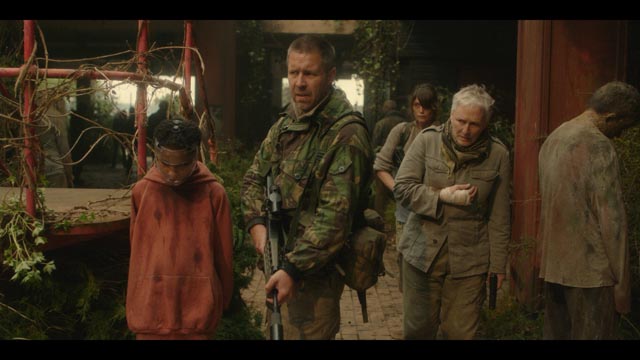
The little group make their way across country and eventually to London, which is completely infested with zombies. It’s here that the film’s particular innovation reveals itself: the fungus which creates the zombies is essentially turning its victims into human-plant hybrids … and the longer people are infected, the more plant-like they become. At the centre of the city, many have become absorbed into a vast tangle of vines which envelope the buildings, growing seed pods full of the zombie spores. If these pods crack open, there’ll be no escape for any of the remaining survivors. But given how cruel and violent people have been, Helen isn’t sure this is a bad thing – maybe the offspring of the infected, like Melanie, are actually the next stage of evolution and should be allowed to inherit the world.
Though obviously made with limited resources, The Girl with All the Gifts has a fine script by Mike Carey, solid direction by McCarthy, and impressive CGI which transforms London into a mossy apocalyptic landscape. But, perhaps most importantly for a small film like this, the cast is excellent, particularly thirteen-year-old Sennia Nanua, who gives a terrific performance in the central role. (Bare-bones Universal dual-format)
*
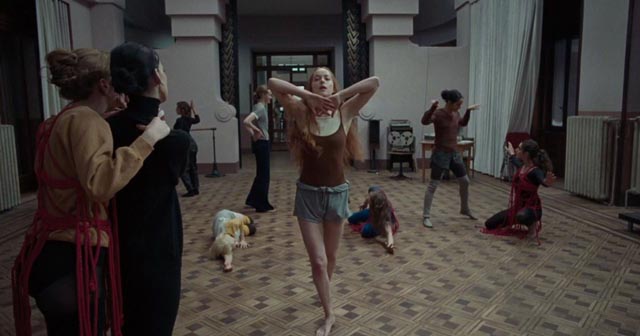
Suspiria (Luca Guadagnino, 2018)
As unpretentious and effective a genre movie as The Girl with All the Gifts is, Luca Guadagnino’s remake of Suspiria is just the opposite. As a long-time fan of Dario Argento’s movie – I first saw it during its original release in 1977 – I’d been avoiding the new version. This is not because I’m absolutely opposed to remakes on principle – there have been some great ones, like Philip Kaufman’s Invasion of the Body Snatchers (1978) or John Carpenter’s The Thing (1982), movies which elaborate on an original idea and create something new. But the problem with something like Suspiria is that what makes the original what it is is not the story or the idea at the heart of the story, but rather the way that story is told.
Argento’s film is, in a sense, all style. The narrative is rather thin and half-baked, but the telling is rich and strange. By the time he made Suspiria, he was already moving away from the idea of story and moving towards a purely cinematic expression of mood and tone. This film is about the camerawork and, equally as important, the soundtrack. It’s almost as if Argento were returning to the primal origins of his medium, to the cinema of pure sensation, of a spectacle which absorbs the viewer into itself. You don’t watch Suspiria to engage with the unfolding of the story – an American student arrives at a forbidding dance academy and gradually discovers it’s run by witches; rather, you engage with it moment by moment through the emotional sensations it evokes. It has the primal quality of a fairy tale in which an innocent child is lured into the witch’s house and to save her own life must confront and defeat the powerful witch. The sense of supernatural menace is evoked purely through the combination of lighting, movement and music.
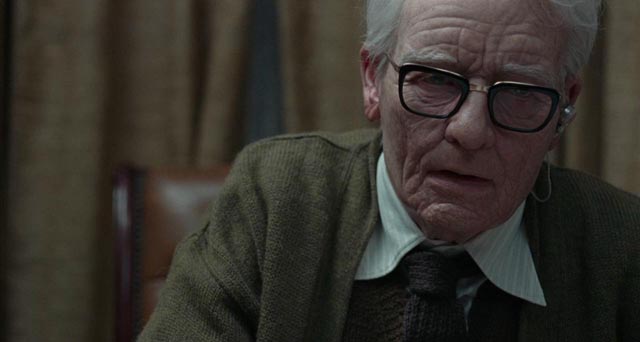
So what’s the idea behind remaking a film like that? It’s like someone coming along and trying to paint a new version of Picasso’s Guernica. What’s the point? Having sat through all two-and-a-half hours of Guadagnino’s Suspiria, I still don’t know. Gone are the lush Technicolor visuals of Luciano Tovoli, gone is the aggressive, primal, haunting soundtrack by Goblin. What’s left is the story of a girl who arrives at a dance academy and discovers that it’s run by witches.
To replace Argento’s style, Guadagnino offers hints of some political meaning. Relocating the story to Berlin in 1977, he drags in the idea of a divided city, a city torn by ideological conflict – this was the time of the Red Army Faction aka the Baader-Meinhof Group, far Left radicals who were engaged in a program of assassinations and bombings. Throughout the movie, there are news reports about these events – arrested members turning up dead in prison, with the authorities claiming that they’d committed suicide; bombs exploding in the streets around the academy. And inside the academy, a coven of witches representing a more ancient, less transient form of evil … or something.
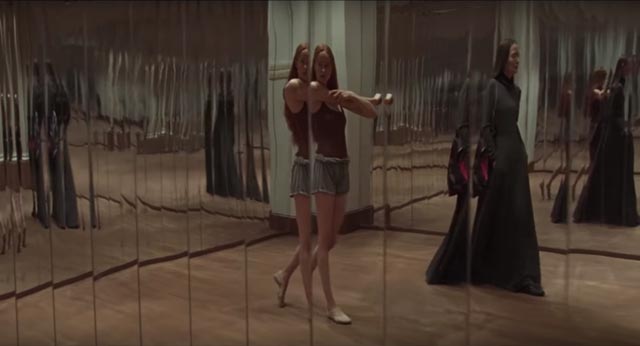
Unlike Argento, Guadagnino reveals the presence of the witches pretty much off the top. We see them sitting in council, voting on who’s to become their new leader. There are conflicts among them, the vote going against the head of the academy, Madame Blanc (Tilda Swinton), in favour of Helena Markos (also Tilda Swinton). While this internal power struggle goes on, American Susie Bannion (Dakota Johnson) arrives at the academy. Madame Blanc immediately senses some power in the new girl and Susie quickly asserts herself to dominate the other students.
Meanwhile, aging psychologist Dr. Klemperer (also inexplicably played by Tilda Swinton, though the character’s a man) is investigating the school because one of the dancers has come to him for treatment, consumed by paranoia about the witches who run the place. Klemperer is a Holocaust survivor who lost his wife to the Nazi death camps. What does this mean in terms of the story? I’m not sure, although towards the end he is attacked for having failed to save his wife, essentially blamed for her death … Nazi guilt is transformed into his own personal guilt as a man. To the witches, all men are guilty … but then, at times it seems that Guadagnino is equating the witches’ female power with the roots of Fascism … or something. I really couldn’t decipher the confusing mix of politics, history and fantasy.
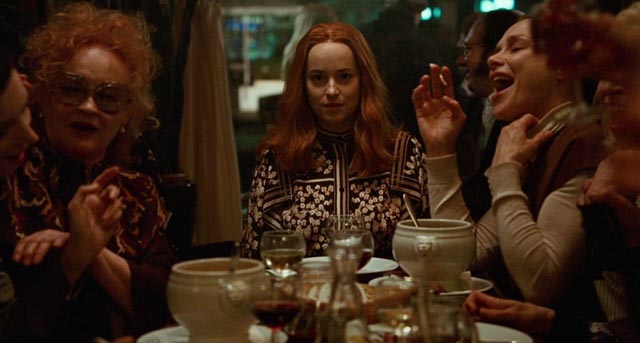
To aggravate the film’s glacial pace, it spends a lot of time on dance. I admit that I’m not at all informed about dance, it’s not something I’m particularly interested in, so I can’t say whether the dance on display at the school is meant to be good or not, but boy does it go on and on. The only time it seems to be clearly tied to the narrative is when Susie’s hidden nature is revealed through a performance in class, her movements being rewritten in the flesh of another student trapped in a room below. Yes, Susie herself is a witch – one whose identity is revealed in the climactic ritual which takes place deep below the school amidst the cheesy writhings of a lot of semi-naked cultists.
In a deliberate move to separate the remake from the original, Suspiria 2018 is shot in muted colours which give it a cold, flat look and its languid visuals are accompanied by a barely-there minimal score by Thom Yorke. All the elements come together so lethargically, that it feels even longer than it actually is. I had to make a conscious effort to stick with it to the end as exhaustion and irritation became almost overwhelming.
In a very short clip included on the disk, Guadagnino says that seeing Argento’s film as a child had a huge impact on him and contributed to his desire to become a filmmaker. But sitting through this new version, I could find no clues about why he would have chosen to remake a film of such distinctive, idiosyncratic qualities. (Universal Blu-ray with a couple of barely-there EPK clips)
Comments